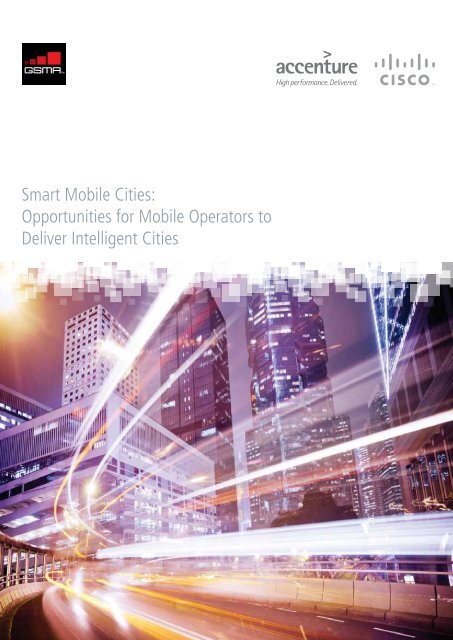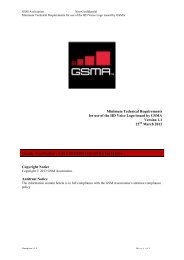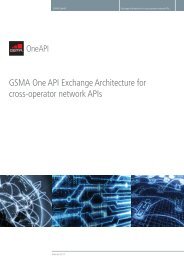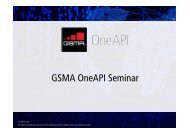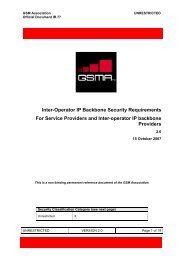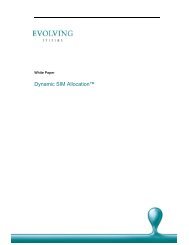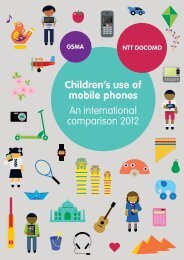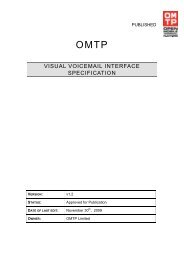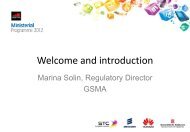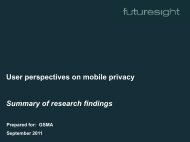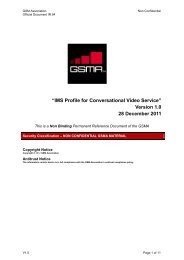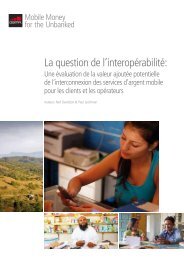Smart Mobile Cities: Opportunities for Mobile Operators to ... - GSMA
Smart Mobile Cities: Opportunities for Mobile Operators to ... - GSMA
Smart Mobile Cities: Opportunities for Mobile Operators to ... - GSMA
You also want an ePaper? Increase the reach of your titles
YUMPU automatically turns print PDFs into web optimized ePapers that Google loves.
<strong>Smart</strong> <strong>Mobile</strong> <strong>Cities</strong>:<br />
<strong>Opportunities</strong> <strong>for</strong> <strong>Mobile</strong> <strong>Opera<strong>to</strong>rs</strong> <strong>to</strong><br />
Deliver Intelligent <strong>Cities</strong>
Acknowledgements<br />
Contents<br />
Accenture, Cisco and the <strong>GSMA</strong>, the co-authors of this report, would like <strong>to</strong> thank the<br />
following contribu<strong>to</strong>rs:<br />
Carlo Ratti PhD - Senseable City Labora<strong>to</strong>ry MIT<br />
Kristian Kloeckl PhD – Senseable City Labora<strong>to</strong>ry MIT<br />
Euro Beinat PhD – Co-Founder, Current City Research Foundation<br />
Brian Dobson, Digital Manager - TfL<br />
Simon Giles, Direc<strong>to</strong>r <strong>for</strong> <strong>Smart</strong> Technology Strategy - Accenture<br />
Mark Spelman, Global Head of Strategy - Accenture<br />
Taco de Vries, Direc<strong>to</strong>r <strong>for</strong> <strong>Smart</strong> Grid Services - Accenture<br />
Jenny Hawes, Strategy Manager - Accenture<br />
Chiara Mizzoni, Analyst - Accenture<br />
Nicola Villa, Senior Direc<strong>to</strong>r, Urban Innovation, Internet Business Solutions Group - Cisco Systems, Inc<br />
Caspar Herzberg, Senior Direc<strong>to</strong>r, <strong>Smart</strong>+Connected Communities - Cisco Systems, Inc<br />
Elisabeth Zornes, Senior Direc<strong>to</strong>r, <strong>Smart</strong>+Connected Communities - Cisco Systems, Inc<br />
Bas Boorsma, Direc<strong>to</strong>r, Urban Innovation, Internet Business Solutions Group– Cisco Systems, Inc<br />
Stuart Taylor, Managing Direc<strong>to</strong>r, Internet Business Solutions - Cisco Systems, Inc<br />
Parker Moss, Head of Strategy - <strong>GSMA</strong><br />
Richard Mooney, Direc<strong>to</strong>r of Strategy - <strong>GSMA</strong><br />
Svetlana Grant, Project Manager - <strong>GSMA</strong><br />
1: Executive Summary 2<br />
2: The Challenges of Sustainable Urbanisation and Climate Change 3<br />
3: Intelligent <strong>Cities</strong> as the Solution 5<br />
4: Role of the Telecoms Opera<strong>to</strong>r 11<br />
5: <strong>Mobile</strong> <strong>Opera<strong>to</strong>rs</strong>’ Intelligent City Propositions 15<br />
6: Prioritised Opera<strong>to</strong>r <strong>Opportunities</strong> 17<br />
7: Conclusion and Next Steps 23<br />
8: Sources 24<br />
Accenture is a global management consulting, technology services and outsourcing<br />
company, with more than 215,000 people serving clients in more than 120 countries.<br />
Combining unparalleled experience, comprehensive capabilities across all industries and<br />
business functions, and extensive research on the world’s most successful companies,<br />
Accenture collaborates with clients <strong>to</strong> help them become high-per<strong>for</strong>mance businesses<br />
and governments. The company generated net revenues of US$21.6 billion <strong>for</strong> the fiscal<br />
year ended Aug. 31, 2010. Its home page is www.accenture.com.<br />
Cisco (NYSE: CSCO) is the worldwide leader in networking that trans<strong>for</strong>ms how people<br />
connect, communicate and collaborate. In<strong>for</strong>mation about Cisco can be found at<br />
http://www.cisco.com. For ongoing news, please go <strong>to</strong> http://newsroom.cisco.com.<br />
The <strong>GSMA</strong> represents the interests of mobile opera<strong>to</strong>rs worldwide. Uniting nearly<br />
800 of the world’s mobile opera<strong>to</strong>rs and more than 200 companies in the broader<br />
mobile ecosystem, the <strong>GSMA</strong> is focused on innovating, incubating and creating new<br />
opportunities <strong>for</strong> its membership and driving the growth of the mobile industry.<br />
Disclaimer<br />
The views, opinions and conclusions expressed in the report are solely those of the<br />
authors and will not necessarily reflect the views of the <strong>GSMA</strong>, its Members or<br />
Associate Members.<br />
Copyright © 2011 Accenture, Cisco, Inc and <strong>GSMA</strong>. All Rights Reserved
1<br />
1 Executive Summary 1 - 2<br />
Executive Summary<br />
The twin challenges of rapid urbanisation<br />
and climate change are contributing <strong>to</strong><br />
the scarcity of resources in cities in both<br />
developed and developing markets. <strong>Cities</strong><br />
around the world are suffering resources<br />
constraints in energy supply, road capacity,<br />
water reserves and even clean air <strong>for</strong><br />
their citizens <strong>to</strong> breathe. New solutions<br />
are urgently required <strong>to</strong> cope with these<br />
resource challenges <strong>to</strong> ensure that the<br />
city of the future is a safe, healthy and<br />
desirable place <strong>for</strong> its citizens <strong>to</strong> live,<br />
work and play.<br />
<strong>Smart</strong> cities employ innovative digital services layers, that use sensing & control,<br />
analytics and ubiqui<strong>to</strong>us communications, <strong>to</strong> optimise scarce resources. Empowered<br />
<strong>to</strong> make better decisions about how <strong>to</strong> travel or transport goods more efficiently and<br />
<strong>to</strong> understand the real time cost of using electrical appliances, the city’s citizens and<br />
businesses will make better use of these resources. As a result, cities will allocate<br />
resources more efficiently; in parallel saving costs and transitioning <strong>to</strong> a low carbon<br />
economy.<br />
<strong>Mobile</strong> opera<strong>to</strong>rs have a fundamental role <strong>to</strong> play in this emerging multibillion dollar<br />
value chain. i <strong>Opera<strong>to</strong>rs</strong> collectively own the network infrastructure best placed <strong>to</strong> deliver<br />
digital urban services <strong>to</strong> future citizens. <strong>Opera<strong>to</strong>rs</strong> are also well positioned <strong>to</strong> provide<br />
the technology plat<strong>for</strong>m from which these future services can be delivered, and in some<br />
markets, <strong>to</strong> deliver end-<strong>to</strong>-end services direct <strong>to</strong> consumers. Beyond the technology<br />
challenge, there is also a significant need <strong>to</strong> orchestrate the disparate ecosystems, which<br />
is something that opera<strong>to</strong>rs are well placed <strong>to</strong> achieve. However, they need <strong>to</strong> act soon<br />
<strong>to</strong> seize this opportunity, as competition is intense in all layers of smart city services<br />
provision.<br />
A large volume of literature on ‘<strong>Smart</strong>’ or ‘Intelligent’ cities has been produced, but little<br />
analysis has been done on the business propositions <strong>for</strong> specific smart city value chain<br />
participants, such as mobile opera<strong>to</strong>rs. This report focuses on the communications<br />
technology value proposition within new build, developing market and developed<br />
market smart cities. The purpose of the report is <strong>to</strong> encourage telecom opera<strong>to</strong>rs <strong>to</strong> focus<br />
investment and resources on the smart city market opportunity. It is also designed <strong>to</strong><br />
equip opera<strong>to</strong>rs with compelling arguments <strong>for</strong> persuading mayors and city governance<br />
bodies <strong>to</strong> develop a smart city vision and roadmap <strong>for</strong> the next decade (with telecom<br />
opera<strong>to</strong>rs as valuable partners <strong>to</strong> help with the delivery of this vision).<br />
This report identifies mobile payments and ticketing, intelligent energy management and<br />
analytics and commercial insight as the initial opportunities that opera<strong>to</strong>rs should look<br />
<strong>to</strong> pursue in cities around the world. These services combine the largest benefit with<br />
the greatest ease of implementation, and are there<strong>for</strong>e most applicable opportunities <strong>for</strong><br />
near-term, large-scale pilots.
2<br />
2 The Challenges of Sustainable Urbanisation and Climate Change 3 - 4<br />
The Challenges of Sustainable Urbanisation<br />
and Climate Change<br />
The UN estimates that at some point<br />
between 2008 and 2009 the world’s urban<br />
and rural populations became equal in<br />
size <strong>for</strong> the first time in human his<strong>to</strong>ry.<br />
Urbanisation is set <strong>to</strong> continue as the rural<br />
population seek the wealth and social<br />
opportunity that cities offer. In the period<br />
from 2007 <strong>to</strong> 2050, the UN estimates the<br />
urban popul¬ation will grow from 3.1bn <strong>to</strong><br />
6.4bn. ii In China alone, it is estimated that<br />
18 million people per year move <strong>to</strong> urban<br />
environments and, that by 2025, China will<br />
have 221 cities with over 1 million people<br />
(Europe has 35 <strong>to</strong>day). iii Population shifts<br />
on this scale have never been seen be<strong>for</strong>e<br />
and will create tremendous infrastructure<br />
challenges.<br />
<strong>Cities</strong> are currently responsible <strong>for</strong> around 80% of global carbon emissions. iv Despite<br />
occupying only 2% of global land area, cities consume around 75% of the world’s<br />
resources. v Much of the growth in resource consumption is coming from non-OECD<br />
emerging economies, where energy demand is expected <strong>to</strong> increase by 73% between 2006<br />
and 2030. vi As cities around the world grow in size, we are beginning <strong>to</strong> see that strained<br />
resources, infrastructure and services are causing natural limits <strong>to</strong> urban growth, which<br />
in turn limits the economic growth opportunity. In parallel with the growth, many<br />
existing cities need <strong>to</strong> start upgrading their obsolete infrastructures, which have been<br />
deployed over the past 10-40 years.<br />
The challenge of managing sustainable urban growth is one of the defining challenges<br />
of the 21st century. City leaders, mayors and other politicians are already wrestling<br />
with these challenges and are looking <strong>to</strong> make changes that will position their cities <strong>for</strong><br />
growth, as attractive centres <strong>for</strong> investment and innovation and as fulfilling places <strong>to</strong><br />
live.<br />
These set of challenges represent a significant opportunity <strong>for</strong> investments in “smart”<br />
urban infrastructure. Cisco estimates that $1.2 trillion vii will need <strong>to</strong> be invested in ICT<br />
and “smart” urban infrastructure worldwide over the next decade.<br />
However, in this era of tight governmental budget constraints, capital-efficient solutions<br />
delivered by highly competitive public private partnerships are likely <strong>to</strong> be the business<br />
model that wins favour with municipal buyers. Additionally, ICT has an important<br />
role <strong>to</strong> play <strong>to</strong> improve and ensure efficient resource allocation. <strong>Cities</strong> need <strong>to</strong> deploy<br />
common plat<strong>for</strong>ms across multiple service layers <strong>to</strong> drive economies of scope and scale,<br />
and <strong>to</strong> generate a unified and coherent ‘cus<strong>to</strong>mer experience’ <strong>for</strong> their citizens. However,<br />
this will increase the complexity of the urban ecosystem of digital services, driving a<br />
greater-than-ever need <strong>for</strong> effective partnerships and clear-sighted orchestration <strong>to</strong> align<br />
the large number of stakeholders. Telecom opera<strong>to</strong>rs are well placed <strong>to</strong> play a strategic<br />
role in creating and orchestrating these ecosystems.<br />
Oulu, Finland, population 150,000.<br />
Oulu City is leading and orchestrating a smart city<br />
programme. It uses a Public Private Partnership<br />
(PPP) based on a living lab concept, in which no<br />
incubation is required because the whole city<br />
becomes the lab <strong>for</strong> new services. Living labs have<br />
now spread throughout Europe and further afield.<br />
(see http://www.openlivinglabs.eu/)<br />
n The PPP has public funding of €180 million<br />
and private funding of €130 million:<br />
n The municipality advocates, endorses and funds<br />
advertising and communications <strong>for</strong> new urban<br />
services <strong>to</strong> the citizens, and incubates the<br />
service development by testing it directly on<br />
the population, as per the living lab concept. It<br />
also provides city furniture and infrastructure <strong>to</strong><br />
be used in the pilot.<br />
n The city uses the living lab <strong>to</strong> win inward<br />
investment in<strong>to</strong> the city. The concept<br />
encouraged, <strong>for</strong> example, Ericsson <strong>to</strong> move a<br />
major R&D lab <strong>to</strong> the city.<br />
n Oulu now has 1,200 WiFi hot spots covering<br />
the majority of the populated area in the Oulu<br />
region. This Oulu network is used by over<br />
20,000 people every month.
3<br />
3 Intelligent <strong>Cities</strong> as the Solution 5 - 6<br />
Intelligent <strong>Cities</strong> as the Solution<br />
Defining the Intelligent City<br />
There is no agreed definition of an Intelligent City. Based on our research and experience<br />
we suggest that an Intelligent City should exhibit the following common principles:<br />
n A city in which citizens and services providers have access <strong>to</strong> enhanced in<strong>for</strong>mation flow.<br />
Such city maximises the utilisation of its key resources by leveraging data gathered through widespread<br />
embedded sensors and controls, real time data analytics and ubiqui<strong>to</strong>us communications.<br />
n A city which combines disparate data sets <strong>to</strong> offer productivity insights and enhancement <strong>to</strong><br />
its citizens and service providers.<br />
n A city which maximises the economies of scope and scale across its multiple infrastructure<br />
layers through a common service delivery plat<strong>for</strong>m, or Urban Operating System (“Urban OS”).<br />
n A city which uses innovative technology and innovation <strong>to</strong> strive <strong>to</strong> go beyond economic<br />
targets, <strong>to</strong> deliver sustainable, quality of life improvements <strong>for</strong> its citizens, its industry and the local<br />
environment.<br />
Enhanced in<strong>for</strong>mation will lead <strong>to</strong> significant urban services innovation, with increasing<br />
GDP growth, a reduction in government costs, the creation of a sustainable environment<br />
and the enhanced wellbeing of the citizens.<br />
The services that will deliver these benefits may include:<br />
n <strong>Smart</strong> grid technology <strong>to</strong> empower end users <strong>to</strong> be more efficient with their energy uses, and <strong>to</strong><br />
allow utility companies <strong>to</strong> proactively identify and repair energy or water leakage.<br />
n <strong>Smart</strong> traffic control through sensors in roadside furniture <strong>to</strong> proactively reroute traffic <strong>to</strong> avoid<br />
congestion and maximise road utilisation.<br />
n <strong>Smart</strong> CTV/surveillance cameras <strong>to</strong> measure real-time footfall mashed up with weather and events<br />
data, <strong>to</strong> alert transport networks, police, and retailers in real time <strong>to</strong> spikes in footfall.<br />
n mHealth remote moni<strong>to</strong>ring solutions <strong>to</strong> help chronically ill patients remain longer at home, with<br />
data that is integrated with care-provider scheduling <strong>to</strong>ols <strong>to</strong> optimise home visits around medical need.<br />
n In-vehicle telematics <strong>to</strong> improve the attractiveness of eVehicle adoption by directing drivers <strong>to</strong><br />
charging stations, taking in<strong>to</strong> account queue times and availability.<br />
n Data records of urban activity will lead <strong>to</strong> more efficient long-term planning <strong>to</strong>ols <strong>for</strong> urban<br />
planners, city services, policy and transport systems, and also private sec<strong>to</strong>r infrastructure inves<strong>to</strong>rs.<br />
An Intelligent City can also use enhanced in<strong>for</strong>mation flow <strong>to</strong> stimulate behaviour<br />
change amongst citizens and service providers. For example:<br />
n Public service or private sec<strong>to</strong>r pricing models can be made dependent on real-time demand – whether<br />
that is <strong>for</strong> energy supply, or access <strong>to</strong> a bike <strong>for</strong> hire. Envisage a situation where transport is priced in<br />
real time <strong>to</strong> reflect the demand <strong>for</strong> that service – <strong>for</strong> example, bike hire from <strong>to</strong>urist centres is priced at<br />
a premium <strong>to</strong> reflect its value.<br />
n Micropayments can be used <strong>to</strong> incentivise community-wide behaviour change. For example, small<br />
micropayment remuneration (via mobile phones) was used in Jakarta <strong>to</strong> incentivise individuals <strong>to</strong><br />
increase rates of waste recycling. viii<br />
n Social exclusion can be addressed as mobile devices become more af<strong>for</strong>dable and reach previouslyisolated<br />
parts of society - a large number of people in emerging markets lack access <strong>to</strong> traditional<br />
payment methods or banking services, which reduces their likelihood <strong>to</strong> pay <strong>for</strong> basic services that<br />
would greatly aid development.
3 Intelligent <strong>Cities</strong> as the Solution 7 - 8<br />
The City Archetype<br />
At first glance, smart city infrastructure may appear <strong>to</strong> mainly be a developed world<br />
opportunity. However, upon further analysis it becomes clear that the opportunities<br />
are perhaps even more compelling in developing world cities, where user behaviour is<br />
overtaking developed markets and urban conurbations are transitioning from no services<br />
directly <strong>to</strong> digital services. A good example is Kenya, which had very little consumer<br />
banking infrastructure 5 years ago, be<strong>for</strong>e Kenyan mobile opera<strong>to</strong>r Safaricom launched<br />
its mobile payment service. By the end of 2008, just 2 years after the launch, 5 million<br />
cus<strong>to</strong>mers were using M-Pesa mobile wallets and mobile payments <strong>for</strong> securing their<br />
savings and, in many cases, <strong>to</strong> pay <strong>for</strong> urban services such as gas and electricity supply. ix<br />
Over the past two years we have seen the concept of Intelligent or <strong>Smart</strong> <strong>Cities</strong><br />
transfer from the conference circuit <strong>to</strong> the strategic agenda of national governments,<br />
multinational infrastructure providers and system integra<strong>to</strong>rs.<br />
We even see examples, particular in East Asia, where governments are backing <strong>Smart</strong><br />
City pilots and positioning their industrial champions at the heart of the Intelligent<br />
Urbanisation agenda, with the intention of generating a ‘smart infrastructure’ export<br />
market. For example, in Japan, METI has a program underway with companies, such as<br />
Panasonic, Hitachi, Toshiba and others, <strong>to</strong> develop smart city services that can be tested<br />
in four domestic pilot cities, and eventually sold internationally. Similar strategies are<br />
being followed in Korea and China as well.<br />
There are 3 significant city archetypes that need <strong>to</strong> be considered somewhat differently:<br />
n New build cities<br />
n Developed market cities<br />
Developed Market <strong>Cities</strong> - In the developed world, the primary driver <strong>for</strong> adopting an<br />
Intelligent City vision is typically <strong>to</strong> ensure that energy demand does not over-run<br />
supply by adopting ‘green’ energy practices, which should in turn lead <strong>to</strong> lower carbon<br />
emissions. Amsterdam, <strong>for</strong> example, is striving <strong>for</strong> a 40% reduction in carbon emissions<br />
by 2025. x Additionally, many developed market cities have decaying infrastructure that<br />
is reaching end-of-life, heralding a new infrastructure investment cycle. Many utility<br />
companies and service providers are beginning <strong>to</strong> use ‘smart’ functionality as a criteria in<br />
the tender process <strong>to</strong> distinguish vendors’ value propositions, as infrastructure contracts<br />
come up <strong>for</strong> renewal.<br />
A major challenge <strong>for</strong> achieving economies of scope and scale across multiple digital<br />
service layers is that developed market infrastructure supply tends <strong>to</strong> be highlyliberalised,<br />
which means the mayor and the municipal governance body has little direct<br />
influence on the roadmaps of the urban service providers.<br />
Developing Market <strong>Cities</strong> - In the developing world context, the primary challenge <strong>for</strong><br />
cities is typically over-congestion (both urban density and traffic volume) caused by<br />
the unprecedented rapidity of urbanisation in the past 10-20 years. A further challenge<br />
is <strong>to</strong> develop the educational, transport and communication infrastructure <strong>to</strong> incubate<br />
talent and <strong>to</strong> attract industry and commerce. While developing market cities are<br />
often burdened by bureaucracy, they typically have the advantage of having relatively<br />
centralised and <strong>to</strong>p-down municipal governance structures, which mean that a city<br />
mayor has the influence <strong>to</strong> sponsor and promote large scale infrastructure projects, such<br />
as the implementation of a smart grid or eVehicle programme. This means that it is<br />
easier <strong>to</strong> find ‘a single buyer’ in a developing market city and it increases the potential<br />
<strong>for</strong> multiple digital infrastructure layers <strong>to</strong> be contained on a single plat<strong>for</strong>m.<br />
n Developing market cities<br />
New Build <strong>Cities</strong> - In Asia and the Middle East we have seen the emergence of the<br />
‘new build’ Intelligent City. The highest profile of these cities is Masdar in Abu Dhabi<br />
and Songdo in Korea. These showcase cities help <strong>to</strong> build momentum and accelerate<br />
the move <strong>to</strong> a broader intelligent infrastructure, by demonstrating successful service<br />
offerings case studies that can be transferred <strong>to</strong> other urban environments.
3 Intelligent <strong>Cities</strong> as the Solution 9 - 10<br />
The Intelligent City Value Chain<br />
The Intelligent City value chain starts at the point where data about the citizens and the<br />
urban environment is generated. That data is then analysed, combined with other services<br />
and delivered through useful and targeted applications and interfaces <strong>to</strong> end cus<strong>to</strong>mers.<br />
Providers have the opportunity <strong>to</strong> assume different roles across different parts of the value<br />
chain from a pure access play <strong>to</strong> full service delivery.<br />
Exhibit 1: Intelligent City value chain<br />
The five steps <strong>to</strong> the Intelligent City Value Chain:<br />
n Data is collected from a wide range of devices including mobile phones, traditional computing devices<br />
and embedded sensors and actua<strong>to</strong>rs within new devices, such as home appliances and vehicles, as well<br />
as from fixed infrastructure, such as roadside furniture, buildings, water systems or weather stations.<br />
n Data backhauled by communications networks via a combination of fixed and wireless<br />
infrastructure depending on the mobility of the application and bandwidth and latency requirements.<br />
In many residential emerging market settings, mobile networks may be the only option.<br />
<strong>Mobile</strong> Data<br />
M2M Data<br />
Infrastructure<br />
Embedded Data<br />
Connectivity<br />
Access<br />
Data Management<br />
and Analytics<br />
Order mgt<br />
Price mgt<br />
Service Delivery<br />
Plat<strong>for</strong>m<br />
Financial mgt<br />
Cus<strong>to</strong>mer mgt<br />
Applications<br />
Websites<br />
Cus<strong>to</strong>mer<br />
Interface<br />
Portals<br />
Messaging<br />
Transport<br />
<strong>Smart</strong> Energy<br />
mHealth<br />
<strong>Smart</strong> Buildings<br />
n Data is analysed and warehoused in a central data management plat<strong>for</strong>m which s<strong>to</strong>res, tags and<br />
processes large data sets in the cloud.<br />
n The data feeds a Service Delivery Plat<strong>for</strong>m (“SDP”) that sits on <strong>to</strong>p of the data warehouse and<br />
runs the ‘order <strong>to</strong> payment’ process <strong>for</strong> city services. It contains several discrete modules, <strong>for</strong> example<br />
price management, booking, fulfilment, billing, relationship management and analytics around a vast<br />
range of citizen services. The SDP should have open APIs <strong>to</strong> encourage a developer community <strong>to</strong><br />
generate fresh insights and innovative new services.<br />
n The user interface, accessed by citizens, businesses and service providers, would be freely available<br />
via web services on mobile or desk<strong>to</strong>p plat<strong>for</strong>ms. Innovation and competition should lead <strong>to</strong> a rich set<br />
of applications based on open data sets, hosted on the SDP.<br />
Enabling services<br />
Full service delivery<br />
Industry Play<br />
plat<strong>for</strong>m Play<br />
Intelligent<br />
Energy<br />
Citizen<br />
Travel<br />
Optimization<br />
Wireless<br />
Fleet<br />
Management<br />
Remote<br />
Healthcare<br />
<strong>Mobile</strong><br />
Payments<br />
and<br />
Ticketing<br />
Analytics<br />
and<br />
Urban Challenge<br />
■ Access <strong>to</strong> electricity <strong>for</strong> development<br />
■ Unsustainable levels of energy theft<br />
■ Grid inefficiencies<br />
■ Incomplete in<strong>for</strong>mation on<br />
transport options<br />
■ A need <strong>to</strong> reduce urban congestion<br />
■ Integration of EV infrastructure<br />
■ Inefficiencies in supply chains<br />
■ A need <strong>to</strong> reduce trucks rolls <strong>to</strong> save<br />
carbon and reduce urban congestion<br />
■ Reliance on expensive healthcare<br />
delivery models<br />
■ Rapidly ageing population<br />
■ Limited real time data on<br />
patient condition<br />
■ Cost of maintaining multi-channel<br />
ticketing systems<br />
■ Fragmented consumer experience<br />
■ Data sets held in silos<br />
■ Missed opportunities <strong>for</strong> creative<br />
Global Case Study 1<br />
Harnessing the Power of Analytics in<br />
Singapore Mno Based Solution<br />
Project: A mobile LIVE Singapore!<br />
energy management service which<br />
helps consumers manage consumption, enables mobile<br />
LIVE Singapore! payment of energy is a five bill and year remote research disconnect project <strong>for</strong> non- lead<br />
payers, reduces energy theft and identifies energy leakage<br />
by MIT’s SENSEable City Lab and focused on the<br />
development of an unprecedented plat<strong>for</strong>m <strong>for</strong><br />
En route-optimisation <strong>to</strong>ol <strong>to</strong> in<strong>for</strong>m citizens on the<br />
the collection, combination and distribution of most carbon friendly, fast, and inexpensive method of<br />
growing urban number travel based of real-time on time data congestion/pricing sets originating data.<br />
from urban Also enables systems pre-book and car networks, parking and such e-vehicle as vehicle charging<br />
fleets Intelligent (taxi, bus, fleet subway), logistics; telecommunication mobile tracking & networks<br />
(mobile routing phone, via landline, embedded WiFi), telematics, seaport helps and reduce airport<br />
journey times, optimise cargo loading, improve the fleet<br />
operations,<br />
utilisation<br />
environmental<br />
and optimise maintenance<br />
sensor networks,<br />
schedulesand usergenerated<br />
data.<br />
Remote patient-moni<strong>to</strong>ring and healthcare<br />
It is becoming field-<strong>for</strong>ce increasingly au<strong>to</strong>mation evident reduces hospitalisation how the by<br />
combination enabling of patients different <strong>to</strong> self-moni<strong>to</strong>r kinds of from urban home; data optimises can<br />
schedules of care provider visits based on level of need<br />
give radical new insights in<strong>to</strong> how a city works, how<br />
people make use of the physical space and how they<br />
access<br />
A<br />
services.<br />
mobile payment<br />
The ethos<br />
plat<strong>for</strong>m<br />
of the<br />
using<br />
project<br />
NFC,<br />
is one<br />
integrated<br />
of<br />
‘open with innovation’, mobile ticketing, inspired <strong>to</strong> enable by the remote recent ticket data.gov purchase.<br />
This will a common plat<strong>for</strong>m <strong>for</strong> multiple<br />
initiatives. It provides a plat<strong>for</strong>m and <strong>to</strong>olset <strong>to</strong> enable<br />
transport modes/other urban services like stadium access<br />
Management and operational analytics plat<strong>for</strong>m<br />
<strong>for</strong> insight in<strong>to</strong> the city environment . Enables real-time<br />
developer communities <strong>to</strong> join in <strong>to</strong> explore intriguing<br />
new combinations of data and develop applications<br />
that employ the plat<strong>for</strong>m’s real-time streams. In this<br />
sense, public institutions and companies, as well as<br />
individuals, are all invited <strong>to</strong> participate in contributing<br />
data streams that they are interested in sharing<br />
with the public through a common framework. All<br />
data-sharing partners benefit from being able <strong>to</strong> see<br />
beyond their own networks and tap in<strong>to</strong> the vast<br />
creative potential of developer communities <strong>to</strong> find<br />
ways of extracting new value from existing data,<br />
leading <strong>to</strong> innovative insights, as well as new service<br />
opportunities.<br />
One of the project’s key characteristics is that it is<br />
not only one specific application, but a flexible and<br />
scalable plat<strong>for</strong>m. In many ways the plat<strong>for</strong>m is<br />
capable of becoming the ecosystem <strong>for</strong> the new<br />
domain of city programming, allowing new ideas and<br />
functionality <strong>to</strong> be incorporated as they mature.<br />
LIVE Singapore! is in its early stages, but already has<br />
partnered with some of the city’s key ac<strong>to</strong>rs including<br />
1 http://www.lowcarbonsg.com/tag/carbon-emissions/<br />
2 http://www.smartmeters.com/the-news/689-smart-grid-pilot-launched-in-singapore.html<br />
SingTel (a telecoms company), Singapore Power,<br />
Changi Airport, PSA (Singapore’s seaport opera<strong>to</strong>r)<br />
and the National Energy and Environmental Agencies,<br />
as well as the major public and private transportation<br />
providers. The ability <strong>to</strong> bring <strong>to</strong>gether these and<br />
other new data streams opens up several exciting<br />
propositions, such as:<br />
n Meeting Taxi Demand<br />
In Singapore, taxis are in very short supply when<br />
it rains. The level of precipitation is very high, but<br />
also very localized (often <strong>to</strong> within a few km 2 ),<br />
there<strong>for</strong>e the city is exploring combinations of<br />
short-term (10 mins in advance) weather <strong>for</strong>ecasts<br />
with GPS taxi location data <strong>to</strong> help direct taxis <strong>to</strong><br />
the upcoming high demand areas.<br />
n Mapping Carbon Emissions<br />
Singapore has a target of cutting roughly 12<br />
million <strong>to</strong>nnes of CO 2<br />
emissions by 2020. 1 Cars<br />
generate a high proportion of their emissions<br />
whilst accelerating. By using GPS, speed and<br />
accelerometer data on vehicle fleets, new insights<br />
can be gained in real-time regarding where traffic<br />
flows generate high CO 2<br />
emissions. This enables<br />
joggers, bikers and others <strong>to</strong> avoid high pollution<br />
areas and is a valuable input <strong>to</strong> transportation<br />
route planning <strong>to</strong> help reduce emissions.<br />
n Supporting Energy Efficiency<br />
In 2009, Singapore’s Energy Market Authority<br />
launched a smart meter pilot project. By allowing<br />
homeowners <strong>to</strong> access their personal energy<br />
consumption in<strong>for</strong>mation, pilot trials reveal that<br />
they can derive at least a 2% reduction in overall<br />
energy consumption and a 10% reduction in<br />
peak consumption. 2 By overlaying energy data,<br />
various incentives, and consumer attitudes and<br />
preferences, the project can better understand<br />
people’s usage and help <strong>to</strong> tailor the specific<br />
messages <strong>to</strong> drive greater savings.<br />
The value of coalescing these different data sets will<br />
grow over time as the plat<strong>for</strong>m matures. As the pool<br />
of available data grows, the project will enable the<br />
city <strong>to</strong> solve a range of issues, such as congestion,<br />
emissions management, energy efficiency and more.
4<br />
4 Role <strong>for</strong> the telecoms opera<strong>to</strong>r 11 - 12<br />
Role of the Telecoms Opera<strong>to</strong>r<br />
Telecoms opera<strong>to</strong>rs are well placed <strong>to</strong><br />
take a leading role in <strong>Smart</strong> <strong>Cities</strong> but<br />
need <strong>to</strong> act purposefully and quickly <strong>to</strong><br />
optimise their role in the value chain.<br />
As highlighted in exhibit 1, there are three layers of opportunity <strong>for</strong> telecoms opera<strong>to</strong>rs<br />
in Intelligent <strong>Cities</strong> – Communications infrastructure, enabling services and full service<br />
delivery.<br />
Providing communications infrastructure<br />
Backhauling the vast volume of data created by such things as utility meters in smart<br />
grids, traffic in<strong>for</strong>mation sensors in roadside infrastructure and micro-payment data in<br />
mass-transit transport systems requires high capacity ubiqui<strong>to</strong>us network connectivity<br />
that is well integrated with scalable data-centres. Telecoms opera<strong>to</strong>rs’ fixed and<br />
mobile networks are ideally placed <strong>to</strong> deliver the required connectivity and network<br />
intelligence. The busy hour profile of these urban services is likely <strong>to</strong> be out of phase<br />
with the peak times <strong>for</strong> traditional voice and mobile internet traffic, allowing opera<strong>to</strong>rs<br />
<strong>to</strong> improve the asset utilisation of their telecoms networks and augment the business<br />
case <strong>for</strong> capacity increases.<br />
While opera<strong>to</strong>rs are perhaps the natural choice <strong>for</strong> connectivity in the city, their<br />
incumbency is by no means guaranteed. We are seeing increasing numbers of tenders<br />
<strong>for</strong> licensed spectrum by utility companies intent on building their own proprietary<br />
networks, or proposals <strong>to</strong> use powerline networks <strong>to</strong> provide data connectivity<br />
(broadband over powerline). Discussions are even taking place in the au<strong>to</strong>motive<br />
industry about gaining access <strong>to</strong> high-frequency spectrum <strong>for</strong> proprietary vehicle<strong>to</strong>-vehicle<br />
communication. <strong>Opera<strong>to</strong>rs</strong> cannot be complacent in assuming that their<br />
networks will be the default connectivity infrastructure. They need <strong>to</strong> make the case <strong>for</strong><br />
the value of ubiqui<strong>to</strong>us and scalable connectivity <strong>to</strong> the key municipal buyers. Anchor<br />
tenancy of large connectivity municipal clients, in return <strong>for</strong> an accelerated roll out of<br />
high speed networks, could be a powerful bargaining chip <strong>to</strong> convince municipalities of<br />
the strategic value of using telecommunications networks <strong>for</strong> connectivity.<br />
would make the Urban OS “the nerve centre <strong>for</strong> the city....with the potential <strong>to</strong> influence<br />
many urban functions that can help local authorities, service providers, businesses, and<br />
citizens themselves <strong>to</strong> improve the economic, social, and environmental sustainability of<br />
the places they inhabit.” xi<br />
The value of the Urban OS increases with the extent of integration across the multiple<br />
industry verticals and across multiple communication networks. As well as amortising<br />
the plat<strong>for</strong>m costs across multiple verticals, a common plat<strong>for</strong>m also leads <strong>to</strong> a more<br />
consistent experience <strong>for</strong> the end user. Perhaps even more importantly, a common<br />
plat<strong>for</strong>m approach allows data from different industry verticals <strong>to</strong> be combined or<br />
‘mashed up’, <strong>to</strong> generate new data-insights.<br />
The managed service provider of the Urban OS is likely <strong>to</strong> extract significant value from<br />
the urban services value chain, and so we expect this <strong>to</strong> be a highly-contested market.<br />
For this reason, we expect aggressive competition <strong>for</strong> the managed service provider role<br />
<strong>to</strong> come from large software vendors, such as IBM and Microsoft; system integra<strong>to</strong>rs,<br />
such as Accenture and EDS, and infrastructure providers, such as Cisco. Even the SIM<br />
manufacturers have indicated interest in extending their trusted service manager role<br />
<strong>to</strong> providing a subset of the service delivery plat<strong>for</strong>m functions. Telcos will need <strong>to</strong> act<br />
quickly <strong>to</strong> establish themselves as credible competi<strong>to</strong>rs in this land grab <strong>for</strong> urban ICT<br />
influence.<br />
Key functions of the Urban OS<br />
n Authentication, identity management, security,<br />
authorisation<br />
n Device management (pre-provisioning, in<br />
service re-provisioning, disconnect)<br />
n Data-warehousing, mining, analytics, alerts<br />
n Workflow/rules engine<br />
n Location based services<br />
n Developer & test environment, software<br />
development kit (SDK)<br />
n Enterprise integration (APIs, web service)<br />
n Payments, billing and settlement, real time<br />
pricing<br />
n Self-service and cus<strong>to</strong>mer service<br />
Enabling services provider<br />
For consumers <strong>to</strong> interact and transact with municipal services in a private and secure<br />
manner, a sophisticated and horizontally-scalable enabling plat<strong>for</strong>m is required. This<br />
plat<strong>for</strong>m would per<strong>for</strong>m tasks such as authenticating users; obtaining permission<br />
<strong>to</strong> use private data; real-time pricing, payment and transaction capabilities <strong>for</strong> paid<br />
services; secure s<strong>to</strong>rage of data and reporting and analytics on service utilisation. A<br />
technology plat<strong>for</strong>m that delivers services of this type is often called a Service Delivery<br />
Plat<strong>for</strong>m (SDP), but in a city environment this plat<strong>for</strong>m has been defined by several<br />
multinationals as the Urban Operating System (“Urban OS”).<br />
Professor Carlo Ratti (Senseable <strong>Cities</strong> Lab Direc<strong>to</strong>r at MIT) explains, it has been<br />
“difficult <strong>to</strong> moni<strong>to</strong>r urban dynamics in real time.” Traditional methods use head counts,<br />
surveys, aerial inspection and satellite image analysis, but they are “costly and slow <strong>to</strong><br />
produce quantitative results.” Real-time data collected from opera<strong>to</strong>r networks, and<br />
processed by a service delivery plat<strong>for</strong>m that sits upon an integrated data warehouse,
4 Role <strong>for</strong> the telecoms opera<strong>to</strong>r 13 - 14<br />
Full service delivery<br />
In some markets telecoms opera<strong>to</strong>rs are already looking <strong>to</strong> provide full end-<strong>to</strong>-end<br />
service delivery of urban services, including connectivity, the technology plat<strong>for</strong>m<br />
and an opera<strong>to</strong>r-branded consumer service. The <strong>GSMA</strong> has conducted extensive<br />
case studies on opera<strong>to</strong>r pilots and full scale launches of branded mHealth solutions,<br />
transport solutions, ticketing and mass-transit solutions and mobile-enabled smart<br />
metering services. These initiatives clearly demonstrate that opera<strong>to</strong>rs can be successful<br />
in full service delivery beyond their traditional communication services.<br />
Full service delivery is clearly the most challenging strategy <strong>for</strong> opera<strong>to</strong>rs, because<br />
it requires significant investments and insights in<strong>to</strong> adjacent markets that are likely<br />
already crowded, highly organised and (depending on the services offered) can offer<br />
lower margins than opera<strong>to</strong>rs are accus<strong>to</strong>med <strong>to</strong>. In addition, many municipal services,<br />
such as remote-healthcare or mass-transit, would likely require multi-service provider<br />
tenders, requiring opera<strong>to</strong>rs <strong>to</strong> collaborate in providing the plat<strong>for</strong>m - traditionally a<br />
highly competitive aspect of the telecoms business.<br />
The adoption of a collaborative services plat<strong>for</strong>m in no way prevents opera<strong>to</strong>rs from<br />
delivering competitive services on <strong>to</strong>p of this plat<strong>for</strong>m. The plat<strong>for</strong>m must be seen as<br />
the enabler and not the differentia<strong>to</strong>r in delivering attractive services <strong>to</strong> end users.<br />
Why telecom opera<strong>to</strong>rs are well placed<br />
Telecoms opera<strong>to</strong>rs have many attributes that position them well <strong>to</strong> be the managed<br />
service provider in the <strong>Smart</strong> City value chain. These attributes include the following:<br />
n Trusted brand – valued <strong>for</strong> high availability, QOS, privacy, security<br />
n Sophisticated authentication and billing capability, potentially integrated across multiple bearer<br />
networks (fixed, mobile, WiFi).<br />
n Mass-market cus<strong>to</strong>mer care and self-service capability<br />
n Consumer and commercial distribution and marketing channels<br />
n Real-time cus<strong>to</strong>mer insight – presence, location, usage<br />
n Data centre scale<br />
n Technology expertise in both networking and IT
5<br />
5 <strong>Mobile</strong> Opera<strong>to</strong>r’s Intelligent City Propositions 15 - 16<br />
<strong>Mobile</strong> Opera<strong>to</strong>r’s Intelligent <strong>Mobile</strong> City Data Propositions<br />
A successful pitch <strong>to</strong> a municipal buyer<br />
from mobile opera<strong>to</strong>rs must include a<br />
compelling long term vision, but also<br />
some near term pilot opportunities that<br />
can be rolled out and tested. Some<br />
services are very attractive private<br />
sec<strong>to</strong>r propositions as they can be<br />
readily monetized.<br />
M2M Data<br />
Connectivity<br />
Data Management<br />
and Analytics<br />
Order mgt<br />
Price mgt<br />
Service Delivery<br />
Plat<strong>for</strong>m<br />
Financial mgt<br />
Cus<strong>to</strong>mer mgt<br />
Applications<br />
Websites<br />
Cus<strong>to</strong>mer<br />
Interface<br />
Portals<br />
Messaging<br />
Transport<br />
<strong>Smart</strong> Energy<br />
mHealth<br />
Other Infrastructure services have greater strategic value <strong>for</strong> the citizens, making them worthy<br />
Embedded Data<br />
<strong>Smart</strong> Buildings<br />
anchor tenant initiatives and investment from municipalities. A successful pilot should<br />
generate immediate commercial and strategic value <strong>for</strong> the citizens and the entire<br />
Access<br />
intelligent city value chain and be relatively quick <strong>to</strong> market and easy <strong>to</strong> implement.<br />
Our research identified six new intelligent Enabling city services business propositions across the value<br />
chain where mobile opera<strong>to</strong>rs can deliver value <strong>to</strong> citizens, and generate new revenue<br />
Full service delivery<br />
streams beyond basic access and connectivity. These services are either industry plays,<br />
solutions targeted at specific industries, or plat<strong>for</strong>m plays that support a diverse range<br />
of intelligent city solutions.<br />
Urban Challenge<br />
Mno Based Solution<br />
Intelligent<br />
Energy<br />
■ Access <strong>to</strong> electricity <strong>for</strong> development<br />
■ Unsustainable levels of energy theft<br />
■ Grid inefficiencies<br />
A mobile energy management service which<br />
helps consumers manage consumption, enables mobile<br />
payment of energy bill and remote disconnect <strong>for</strong> nonpayers,<br />
reduces energy theft and identifies energy leakage<br />
Industry Play<br />
Citizen<br />
Travel<br />
Optimization<br />
Wireless<br />
Fleet<br />
Management<br />
■ Incomplete in<strong>for</strong>mation on<br />
transport options<br />
■ A need <strong>to</strong> reduce urban congestion<br />
■ Integration of EV infrastructure<br />
■ Inefficiencies in supply chains<br />
■ A need <strong>to</strong> reduce trucks rolls <strong>to</strong> save<br />
carbon and reduce urban congestion<br />
En route-optimisation <strong>to</strong>ol <strong>to</strong> in<strong>for</strong>m citizens on the<br />
most carbon friendly, fast, and inexpensive method of<br />
urban travel based on real time congestion/pricing data.<br />
Also enables pre-book car parking and e-vehicle charging<br />
Intelligent fleet logistics; mobile tracking &<br />
routing via embedded telematics, helps reduce<br />
journey times, optimise cargo loading, improve the fleet<br />
utilisation and optimise maintenance schedules<br />
Remote<br />
Healthcare<br />
■ Reliance on expensive healthcare<br />
delivery models<br />
■ Rapidly ageing population<br />
■ Limited real time data on<br />
patient condition<br />
Remote patient-moni<strong>to</strong>ring and healthcare<br />
field-<strong>for</strong>ce au<strong>to</strong>mation reduces hospitalisation by<br />
enabling patients <strong>to</strong> self-moni<strong>to</strong>r from home; optimises<br />
schedules of care provider visits based on level of need<br />
plat<strong>for</strong>m Play<br />
<strong>Mobile</strong><br />
Payments<br />
and<br />
Ticketing<br />
Analytics<br />
and<br />
Commercial<br />
Insight<br />
■ Cost of maintaining multi-channel<br />
ticketing systems<br />
■ Fragmented consumer experience<br />
■ Data sets held in silos<br />
■ Missed opportunities <strong>for</strong> creative<br />
novel insights / revenue generation<br />
A mobile payment plat<strong>for</strong>m using NFC, integrated<br />
with mobile ticketing, <strong>to</strong> enable remote ticket purchase.<br />
This will provide a common plat<strong>for</strong>m <strong>for</strong> multiple<br />
transport modes/other urban services like stadium access<br />
Management and operational analytics plat<strong>for</strong>m<br />
<strong>for</strong> insight in<strong>to</strong> the city environment . Enables real-time<br />
adjustments in resource allocation spanning from energy<br />
supply, traffic routing, police support, or dynamic pricing<br />
of services.<br />
Benefits High<br />
<strong>for</strong> the MNOs, Third Parties and Society.)<br />
Remote Healthcare<br />
Analytics and<br />
Commercial Insight<br />
Citizen Travel<br />
Optimization<br />
Wireless FleetF<br />
<strong>Mobile</strong> Ticketing<br />
Intelligent Energy
6<br />
6 Prioritised Opera<strong>to</strong>r Propositions 17 - 18<br />
Prioritised Opera<strong>to</strong>r Propositions<br />
We assessed these six intelligent city<br />
propositions along two dimensions:<br />
1) expected economic benefits <strong>to</strong><br />
mobile opera<strong>to</strong>rs, third-parties and<br />
society; 2) the ease of implementation<br />
in terms of required capabilities,<br />
regulation and technical challenges.<br />
Based on this screening, mobile<br />
ticketing and payments, intelligent<br />
energy and analytics and commercial<br />
insight are the highest Intelligent<br />
City priorities <strong>for</strong> mobile opera<strong>to</strong>rs <strong>to</strong><br />
pursue.<br />
Strategic Opportunity – <strong>Mobile</strong> Ticketing and Payments<br />
<strong>Mobile</strong> opera<strong>to</strong>rs have an important role <strong>to</strong> play in developing an integrated plat<strong>for</strong>m<br />
<strong>for</strong> managing ticketing and micropayments throughout the urban environment.<br />
For example, public transport is an example of an urban service that involves a high<br />
volume of low value transactions that take place in highly-congested parts of the city.<br />
Both citizens and the transport authority would benefit from moving <strong>to</strong> a cashless<br />
transaction process that enables the purchase and payment <strong>for</strong> tickets <strong>to</strong> be made over<br />
a mobile device. The ticket itself would be distributed back <strong>to</strong> the mobile device, rather<br />
than <strong>to</strong> a proprietary smart card (see below <strong>for</strong> additional details on mobile ticketing).<br />
Most cities <strong>to</strong>day have multiple, independent ticketing systems <strong>for</strong> the different modes<br />
of public transport and other municipal services such as stadium access, library cards,<br />
and museum entry. For example, in Paris, travellers use different payment mechanisms<br />
and ticketing systems <strong>for</strong> the Metro, RER, Paris Bus and Paris Bicycles. The result is a<br />
fragmented user experience, higher rates of theft or loss, and a missed opportunity <strong>for</strong><br />
generating a consolidated data set of urban traffic patterns.<br />
Contactless mobile payment and ticketing could be provided by cities and mobile<br />
opera<strong>to</strong>rs through the use of Near Field Communication (“NFC”) technology. This will<br />
enable consumers <strong>to</strong> use their mobile phones as a contactless payment and ticketing<br />
device. Trials, such as the O2 NFC initiative in London, highlight the potential <strong>for</strong><br />
mobile ticketing services. Payment <strong>for</strong> the ticket may be linked <strong>to</strong> the opera<strong>to</strong>r bill or<br />
third-parties such as Visa, Mastercard or PayPal. <strong>Mobile</strong> ticketing and payment <strong>for</strong><br />
transport represents an ideal opportunity <strong>to</strong> stimulate the broader contactless payment<br />
market in the city, across multiple services. In many cities, contactless infrastructure<br />
is already in place and the benefits of mobile ticketing <strong>for</strong> consumers, opera<strong>to</strong>rs and<br />
transport authorities are clear and well-unders<strong>to</strong>od. Once launched, mobile ticketing<br />
and payments will stimulate the launch of other innovative contactless services across<br />
an Intelligent City. For example, an universal mobile ticketing service will encourage<br />
broad adoption of NFC handsets <strong>for</strong> ticketing and payments which will in turn<br />
stimulate adjacent sec<strong>to</strong>rs (such as retail and other municipal services) <strong>to</strong> invest in<br />
contactless ticketing infrastructure. These innovative new services could include, but<br />
are not limited <strong>to</strong> the following:<br />
n Universal payment (retail, vending machines)<br />
n Data transfer (real time schedules, advertising, real time in<strong>for</strong>mation <strong>for</strong> <strong>to</strong>urists)<br />
n Coupons (PoS redeemable vouchers, loyalty schemes)<br />
n Access (replacement of keys <strong>for</strong> building or vehicle access, personal ID)<br />
n Tracking (asset management, public health and patient tracking, field staff management)<br />
The move <strong>to</strong> mobile ticketing and payments would benefit citizens, public services and<br />
numerous adjacent industries. The retail industry, in particular, will stand <strong>to</strong> benefit as it<br />
is clear that retailers will not invest en masse in mobile ticketing and payment solutions<br />
until there is a strong indication of interest and adoption from the citizens. Mass<br />
adoption of mobile ticketing and payment as the primary public transport ticketing<br />
system would send the ideal signal <strong>to</strong> retailers that consumers are ready <strong>to</strong> shift <strong>to</strong> a<br />
cashless society and that enabled handsets are readily available. This in turn would<br />
stimulate further investment in mobile payment infrastructure in the retail setting.<br />
Municipal support of mobile ticketing and payments <strong>for</strong> its transport infrastructure is a<br />
critical strategic move <strong>to</strong> stimulate the wider market.<br />
Consumers benefit from mobile ticketing and payment by being able <strong>to</strong> use a<br />
single device across all transport plat<strong>for</strong>ms, a consistent user experience, speed and<br />
convenience, security, and near universal availability (e.g., non-credit card holders and<br />
<strong>to</strong>urists). The benefits <strong>for</strong> the city transport provider(s) include reduced costs as a result<br />
of having a scalable, integrated ticketing plat<strong>for</strong>m across all modes of transportation,<br />
dematerialisation (i.e. reload plat<strong>for</strong>ms) and reduced fraud. Tickets could also be<br />
acquired from outside congested stations, reducing crowding and the need <strong>for</strong> multiple<br />
ticketing staff and ticketing machines.
6 Prioritised Opera<strong>to</strong>r Propositions 19 - 20<br />
Global Case Study 2<br />
<strong>Mobile</strong> Payments and Ticketing in Practice<br />
Project: Cityzi in Nice<br />
The Cityzi Project is a large-scale pre-commercial<br />
roll out of mobile contactless services. Cus<strong>to</strong>mers<br />
are able <strong>to</strong> discover, <strong>for</strong> the first time in France, a<br />
multi-service offer of mobile contactless services,<br />
delivered through the support of mobile opera<strong>to</strong>rs<br />
(Bouygues Télécom, SFR and Orange).<br />
The first commercial mobile NFC handsets were<br />
marketed <strong>to</strong> 500,000 residents in the Nice<br />
metropolitan area along with a set of mobile NFC<br />
applications. In the summer of 2010, Orange sold<br />
NFC phones in its nine s<strong>to</strong>res in Nice and nearby<br />
Man<strong>to</strong>n and Beau Soleil. In <strong>to</strong>tal, approximately 30<br />
retailers sold the NFC-enabled phones.<br />
The scope of the initiative covers the entire urban<br />
community of Nice, including the city, as well as the<br />
24 neighbouring communes.<br />
The first services on offer within the framework of<br />
“<strong>Mobile</strong> Contactless Nice” include:<br />
n Public transport: ticketing, passenger<br />
in<strong>for</strong>mation<br />
n Promotion of local heritage and<br />
education: e-campus project<br />
n Trade and retail: local bank transactions,<br />
mobile loyalty and couponing programs<br />
n Cultural/<strong>to</strong>urist in<strong>for</strong>mation: museums<br />
Source: Nice Case Study: I do like <strong>to</strong> be beside the “NFC side” – more in<strong>for</strong>mation at www.orange.cityzi.fr<br />
The Nice transport company, Lignes D’Azur, which<br />
operates buses and the trams in the city, has an<br />
NFC ticketing option similar <strong>to</strong> Oyster in London<br />
or Oc<strong>to</strong>pus in Hong Kong. Cityzi cus<strong>to</strong>mers can<br />
load up the Bpass Java application, resident on<br />
the phone, with credit through an over-the-air<br />
transaction. Tickets can be bought at €1 each, or<br />
<strong>for</strong> €2 with parking, or in packs of €10. Each tram<br />
journey costs €1 and users can have credit of up<br />
<strong>to</strong> €19 on a phone at any one time. The price of<br />
the tickets is charged <strong>to</strong> the subscriber’s phone bill<br />
and the mobile opera<strong>to</strong>r runs a revenue share with<br />
Lignes D’Azur. The phone can be used <strong>to</strong> take the<br />
tram or bus <strong>for</strong> journeys even if the phone’s battery<br />
is flat, although you need a connection <strong>to</strong> add a<br />
ticket <strong>to</strong> the phone.<br />
Perhaps the most powerful part of the technology<br />
is the use of NFC tags with a link <strong>to</strong> the phone’s<br />
web browser. Waving the phone over a tag takes<br />
the browser straight <strong>to</strong> a pre-programmed page,<br />
providing access <strong>to</strong> real-time tram and bus times,<br />
TV listings, news, weather, restaurant booking and<br />
direc<strong>to</strong>ry enquiries.<br />
The scheme has been a huge success and other<br />
cities are anxious <strong>to</strong> replicate the programme.<br />
Strasbourg, Paris and Caen are all scheduled <strong>for</strong><br />
trials in 2011.<br />
Monetisable Opportunity – Intelligent Energy<br />
<strong>Mobile</strong> opera<strong>to</strong>rs will play a crucial role in providing secure and robust communications<br />
infrastructure that will support the deployment of smart meters, and add intelligence <strong>to</strong><br />
the electricity grid globally.<br />
In the developed world, the future of the energy supply is changing rapidly. Aging<br />
infrastructure, decentralization of energy generation and the anticipated arrival of the<br />
electric vehicles in the cities are key drivers behind the need <strong>to</strong> upgrade the existing<br />
utility networks <strong>to</strong> smart grids. By 2020, <strong>for</strong> example, renewable energy is earmarked <strong>to</strong><br />
account <strong>for</strong> 20 per cent of the European Union’s energy consumption. If this objective<br />
is <strong>to</strong> be achieved, consumers and businesses will need <strong>to</strong> become active participants<br />
in the energy supply chain. However, the existing electric grid was designed and<br />
built <strong>to</strong> support large-scale production and one-way energy flow. The introduction<br />
of renewable, distributed sources of energy, such as solar and wind, requires the<br />
construction of an “intelligent” grid, capable of balancing supply and demand. At the<br />
same time, energy companies are aiming <strong>to</strong> minimize grid losses through improvements<br />
in the transmission and distribution networks.<br />
The mass roll out of smart meters <strong>to</strong> individual’s homes in the developed world is<br />
the first step <strong>to</strong>ward making the grid more intelligent. The UK recently announced a<br />
nationwide residential meter roll out <strong>to</strong> 22 million homes. xii In 2009, 76 million smart<br />
metering devices were installed around the world, and that figure is expected <strong>to</strong> increase<br />
more than fourfold <strong>to</strong> 302.5 million smart meters by 2015. xiii In Cali<strong>for</strong>nia alone, Pacific<br />
Gas & Electric plans <strong>to</strong> install 10 million smart meters by 2012. xiv The rationale <strong>for</strong> all<br />
this investment is that better in<strong>for</strong>mation will enable consumers <strong>to</strong> adjust their daily<br />
usage patterns and help smooth peaks in energy demand, thereby reducing the need <strong>for</strong><br />
carbon-intensive power generation <strong>to</strong> cover peak loads.<br />
<strong>Mobile</strong> opera<strong>to</strong>rs may have a key role <strong>to</strong> play in providing connectivity between devices<br />
and the utility company, delivering energy management alerts and applications <strong>to</strong><br />
mobile devices and offering new intelligent energy services <strong>to</strong> consumers. <strong>Opera<strong>to</strong>rs</strong> can<br />
leverage their existing ability <strong>to</strong> transport and bill end-users <strong>for</strong> large amounts of realtime<br />
data and discrete transactions. They can also manage communications networks <strong>for</strong><br />
utilities that chose <strong>to</strong> focus on their core function of generating and distributing energy.<br />
The challenges in emerging markets are somewhat different, where the priority is <strong>to</strong><br />
provide safe, af<strong>for</strong>dable energy <strong>to</strong> a rapidly increasing number of urban residents.<br />
Today, almost 1 in 7 of the global population live in substandard housing or slum<br />
conditions and this number is growing by 500,000 every week. xv In these slum<br />
environments, utilities face high levels of losses on their networks, due <strong>to</strong> inefficiencies<br />
in the electricity supply system (technical losses) and wide scale energy theft through<br />
meter tampering and illegal connections. In some residential areas of Rio, <strong>for</strong> example,<br />
the percentage of energy losses has been recorded at over 50%. xvi Many low-income<br />
citizens lack bank accounts, financial acumen and have limited awareness of their<br />
energy consumption or the methods <strong>for</strong> paying <strong>for</strong> energy. Still, mobile device<br />
penetration is high in low-income areas.
6 Prioritised Opera<strong>to</strong>r Propositions 21 - 22<br />
Global Case Study 3<br />
Intelligent Energy in Practice<br />
Project: Rede Ampla in Rio<br />
Ampla is an electric energy distribu<strong>to</strong>r, owned by<br />
Endesa Brazil, which provides electricity <strong>to</strong> 73% of<br />
the state of Rio de Janeiro, serving over 2 million<br />
cus<strong>to</strong>mers. The rate of urbanisation, the nature of<br />
the accommodation (slums) and the high crime<br />
rate led <strong>to</strong> an unsustainable level of energy theft<br />
and bad credit risk. A large number of cus<strong>to</strong>mers<br />
did not have access <strong>to</strong> personal banking services<br />
and were limited in their ability <strong>to</strong> budget and<br />
manage their finances. Meters at residential and<br />
commercial sites were prone <strong>to</strong> tampering and<br />
bribes <strong>to</strong> employees encouraged fraud.<br />
Ampla was averaging 23.6% energy losses on<br />
its network, reaching up <strong>to</strong> 52% in some areas.<br />
The result was a negative impact on the utility’s<br />
profitability and a higher cost of energy passed<br />
through <strong>to</strong> its cus<strong>to</strong>mers.<br />
In 2003, Ampla began <strong>to</strong> roll out a pilot <strong>for</strong><br />
a new mode of smart meter – located at the<br />
pole <strong>to</strong>p – entitled Rede DAT. With Rede DAT,<br />
the consumption per household is recorded at<br />
the trans<strong>for</strong>mer and energy consumption data<br />
is communicated by the utility over a mobile<br />
network. Energy cus<strong>to</strong>mers receive consumption<br />
data through their mobile phone.<br />
The pilot proved a great success with losses from<br />
theft reduced by more than 50%, the number<br />
of supply interruptions reduced by more than<br />
40%, and lower operating costs. A wider roll out<br />
followed, providing hundreds of thousands of<br />
Ampla’s residential and business cus<strong>to</strong>mers with<br />
access <strong>to</strong> the Rede Ampla service.<br />
Pilot studies have shown that even in very low-income urban regions, where energy<br />
theft is as high as 50%, the majority of households will pay their energy bills if they are<br />
provided with a simple method of payment, quality of service in energy supply and a<br />
reasonable price point. Case studies, such as Ampla (see box below) suggest that energy<br />
theft can be reduced from 50% <strong>to</strong> 10% through a low-cost smart metering scheme,<br />
which uses the mobile device <strong>to</strong> provide energy consumption in<strong>for</strong>mation. Rather than<br />
smart meters located within the residence, a pole <strong>to</strong>p-based “shunt meter” sits on the<br />
distribution network and measures the consumption of tens of households. The device<br />
can identify the usage patterns of the individual households within the cluster, and<br />
can backhaul these energy readings via 3G connections <strong>to</strong> the utility. The application of<br />
mobile networks <strong>to</strong> manage energy is also increasingly common in South Africa where<br />
users buy prepaid energy credit through their mobile phones.<br />
The result of a more efficient electricity distribution grid is that we avoid hundreds<br />
of thousands of <strong>to</strong>nnes of carbon dioxide from entering our atmosphere.<br />
Intelligent energy services empower consumers by providing valuable in<strong>for</strong>mation on<br />
their energy consumption levels. Consumers may also receive support in managing<br />
their bills (e.g. high usage alerts) and options <strong>for</strong> structuring their repayment schedules;<br />
all helping them <strong>to</strong> avoid a bad debt situation. Cus<strong>to</strong>mers can make utility bill payments<br />
directly through their phones, which is especially relevant in those geographies where<br />
people are familiar with using their phone <strong>for</strong> personal banking. Additionally, this<br />
channel can become an important upselling plat<strong>for</strong>m <strong>for</strong> the utility, <strong>for</strong> value-added or<br />
premium services (such as Mi-Fi and/or home entertainment packages).<br />
Anchor Plat<strong>for</strong>m Opportunity – Analytics and Commercial Insight<br />
Intelligent <strong>Cities</strong> rely on a wealth of data, in<strong>for</strong>mation and insights that can guide<br />
real-time decision making and responses, and in<strong>for</strong>m longer term planning. <strong>Cities</strong> are<br />
hungry <strong>for</strong> data that will allow them <strong>to</strong> respond <strong>to</strong> changes in urban dynamics, such<br />
as traffic congestion, pollution threats, health issues and security risks, in a rapid and<br />
effective manner. In addition, they are looking <strong>for</strong> a much richer fact base and insights<br />
<strong>to</strong> help them <strong>to</strong> plan <strong>for</strong> the future in important areas, such as transportation, and utility<br />
build-out. Equally, private sec<strong>to</strong>r companies in everything from retail <strong>to</strong> insurance and<br />
advertising crave better urban in<strong>for</strong>mation on which <strong>to</strong> run their businesses.<br />
<strong>Mobile</strong> opera<strong>to</strong>rs sit on a wealth of valuable urban data. Aggregated and anonymous<br />
data on mobile users’ location can provide a real-time picture of changes in traffic<br />
patterns, congregations or mass exoduses of people, and long-term patterns of<br />
movements of people, indicating the need <strong>for</strong> additional public transportation, or the<br />
ideal site <strong>for</strong> a new s<strong>to</strong>re or billboard advertisement.<br />
Pioneering visualisation techniques employed by the Current City Research Foundation<br />
(www.currentcity.org) are helping <strong>to</strong> provide answers <strong>to</strong> these challenging urban<br />
questions. The team is using sophisticated modelling analysis of aggregated and<br />
anonymous mobile user data, combined with other spatially-aware data <strong>to</strong> produce realtime<br />
maps of urban flows and time patterns. The insights are being used <strong>for</strong> everything<br />
from catastrophe planning, <strong>to</strong> developing better <strong>to</strong>urist strategies, <strong>to</strong> studying the<br />
impact of new urban development projects. Organizations, such as the Dutch Ministry<br />
of Transportation and Waterways (Rijkswaterstaat) and the Netherlands Environmental<br />
Agency (PBL), have seen so much value in this in<strong>for</strong>mation that they decided <strong>to</strong> assess<br />
its use <strong>for</strong> operational and strategic decision making.<br />
The value of this in<strong>for</strong>mation is exponentially increased when it is “mashed-up” with<br />
a diverse range of public data or private, commercial data. The Live Singapore! case<br />
study demonstrates how combining this basic mobile data with weather <strong>for</strong>ecasts can<br />
improve traffic flows and the allocations of taxis. Many municipalities are now working<br />
<strong>to</strong> make all of their public data readily available <strong>for</strong> use by application developers and<br />
third parties. London has created the London Database, making all of its data freely<br />
available – everything from bicycle rental locations, <strong>to</strong> house prices and locations of<br />
local playing fields. Private businesses are interested in combining the mobile and<br />
urban data sets with their own internal sales, operations and cus<strong>to</strong>mer data <strong>to</strong> help them<br />
identify the best location <strong>for</strong> their next s<strong>to</strong>re, or <strong>to</strong> create much better targeted pricing <strong>for</strong><br />
au<strong>to</strong> insurance, <strong>for</strong> example.<br />
Key questions around urban dynamics<br />
n How many people are in a city district?<br />
n Where is traffic congested?<br />
n What is the current demand and supply of<br />
public transportation?<br />
n How much CO2 was emitted <strong>to</strong>day?<br />
n How much footfall passes a specific billboard?<br />
n Where are hot spots <strong>for</strong> crime or infectious<br />
disease?<br />
n Where are potential national security risks?<br />
Source: http://www.funcoge.org.br/juridico/Arquivos/II%20JURIDICO/<br />
Felipe_Filpo_-_Ampla.pdf<br />
Analytics and commercial insights is a core piece of the Intelligent City value chain.<br />
Already numerous parties are positioning themselves <strong>to</strong> be the provider of this<br />
capability. <strong>Mobile</strong> opera<strong>to</strong>rs are in a unique position <strong>to</strong> be the plat<strong>for</strong>m that collects,<br />
s<strong>to</strong>res and integrates these huge and diverse sources of urban data. Not only do they<br />
sit on one of the most important kernels of urban data in the mobile user data, but their<br />
trusted brand, dedication <strong>to</strong> security and vast capabilities and infrastructure make them<br />
prime candidates <strong>to</strong> be the providers of this critical piece of value chain.
7<br />
8<br />
7 Conclusion and Next Steps 8 Sources 23 - 24<br />
Conclusion and Next Steps<br />
Sources<br />
This report has highlighted three<br />
specific opportunities <strong>for</strong> mobile<br />
opera<strong>to</strong>rs <strong>to</strong> assume a key role and<br />
derive benefit from the delivery of<br />
Intelligent <strong>Cities</strong>.<br />
n The roll out of NFC-enabled mobile payments and ticketing <strong>for</strong> mass transit and other urban services,<br />
such as stadium access, parking and bicycle hire, is a strategic investment that will encourage much<br />
further investment in mobile payments in the retail sec<strong>to</strong>r, leading <strong>to</strong> a cashless society, in which mobile<br />
opera<strong>to</strong>rs play a vital role.<br />
n Intelligent energy is an innovative solution <strong>for</strong> conveniently providing urban energy <strong>to</strong> a massively<br />
growing market in developed countries and making energy consumption much more efficient in<br />
developed cities. It provides significant added value <strong>to</strong> all stakeholders and offers mobile opera<strong>to</strong>rs an<br />
important entry point <strong>to</strong> the energy sec<strong>to</strong>r and the opportunity <strong>to</strong> sell higher margin services <strong>to</strong> existing<br />
mobile cus<strong>to</strong>mers.<br />
n Data analytics and commercial insights <strong>for</strong>m the plat<strong>for</strong>m that provides the foundation <strong>for</strong> the<br />
Intelligent City. Combining mobile urban data with vast and diverse public and private data sets,<br />
provides the real-time in<strong>for</strong>mation and insights that allow the Intelligent City <strong>to</strong> operate, plan and<br />
provide additional value <strong>to</strong> its businesses and citizens.<br />
Demographic, environmental, economic and social fac<strong>to</strong>rs are <strong>for</strong>cing the world <strong>to</strong><br />
design and implement Intelligent <strong>Cities</strong>. <strong>Mobile</strong> networks will be a critical component<br />
of these new and re-designed cities. Not only in providing the connectivity glue that<br />
ties all of the devices, in<strong>for</strong>mation and people <strong>to</strong>gether, but mobile networks are also<br />
critical in providing the in<strong>for</strong>mation, insights and value-added services that will truly<br />
make our cities intelligent.<br />
Success will require new capabilities, ways of thinking, strategies, and new partnerships.<br />
<strong>Mobile</strong> opera<strong>to</strong>rs have a great role and opportunity in Intelligent <strong>Cities</strong>, beyond simply<br />
providing network connectivity. Now is the time <strong>for</strong> opera<strong>to</strong>rs <strong>to</strong> begin <strong>to</strong> further<br />
explore and pilot these opportunities .<br />
i<br />
ii<br />
iii<br />
iv<br />
v<br />
http://www.fastcompany.com/magazine/142/the-new-new-urbanism.html?page=0%2C2<br />
http://www.un.org/esa/population/publications/wup2007/2007WUP_Highlights_web.pdf<br />
McKinsey Global Institute „Preparing <strong>for</strong> China’s Urban Billion http://www.mckinsey.com/mgi/reports/<br />
pdfs/china_urban_billion/China_urban_billion_full_report.pdf<br />
Kamal-Chaoui, L. and A. Robert (eds.) (2009), “Competitive <strong>Cities</strong> and Climate Change”,<br />
OECD Regional Development Working Papers N° 2, 2009, OECD publishing, © OECD.<br />
Garnett, T. (1996). “Farming the city: the potential urban agriculture,” The Ecologist, via Factiva,<br />
© 1996 In<strong>for</strong>mation Access Company.<br />
vi International Energy Outlook 2009<br />
vii http://www.fool.com/investing/general/2010/06/23/cisco-joins-a-trillion-dollar-gold-rush.aspx<br />
viii Carlo Ratti Interview November 2010<br />
ix<br />
x<br />
xi<br />
http://www.gsmworld.com/documents/INNOVATIONS-<strong>GSMA</strong>_FINAL-01-22-09.pdf<br />
http://www.nieuwamsterdamsklimaat.nl/publish/pages/171006/report.pdf<br />
http://www.readwriteweb.com/archives/obama_inauguration_check_out_these_real-time_visua.php<br />
xii http://www.decc.gov.uk/assets/decc/legislation/energybill/548-energy-security-bill-brief-smart-meters.pdf<br />
xiii http://www.directionsmag.com/pressreleases/berg-insight-says-worldwide-installed-base-of-smartelectricity-meters-will/121661<br />
xiv http://www.pge.com/myhome/cus<strong>to</strong>merservice/meter/smartmeter/deployment/<br />
xv http://www.nextbillion.net/blog/2009/05/19/hope-<strong>for</strong>-reliable-slum-access-<strong>to</strong>-energy#<br />
xvi http://www.funcoge.org.br/juridico/Arquivos/II%20JURIDICO/Felipe_Filpo_-_Ampla.pdf
For further in<strong>for</strong>mation please contact<br />
info@gsm.org<br />
<strong>GSMA</strong> London Office<br />
T +44 (0) 20 7356 0600<br />
www.gsmworld.com<br />
April 2011<br />
Copyright © 2011 Accenture, Cisco, Inc and <strong>GSMA</strong>. All Rights Reserved


